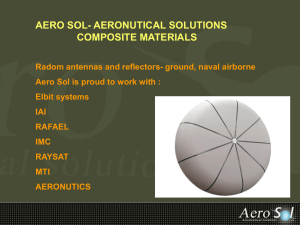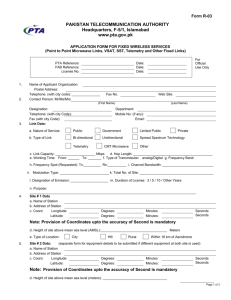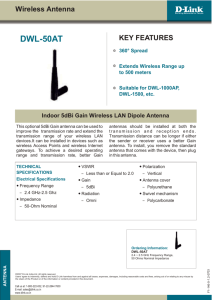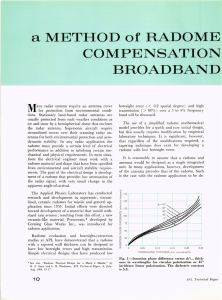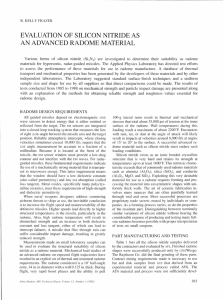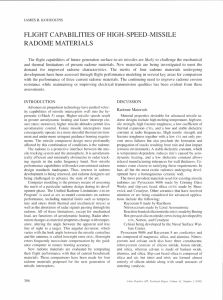VSAT Band Downlink Frequencies Uplink Frequencies C
advertisement
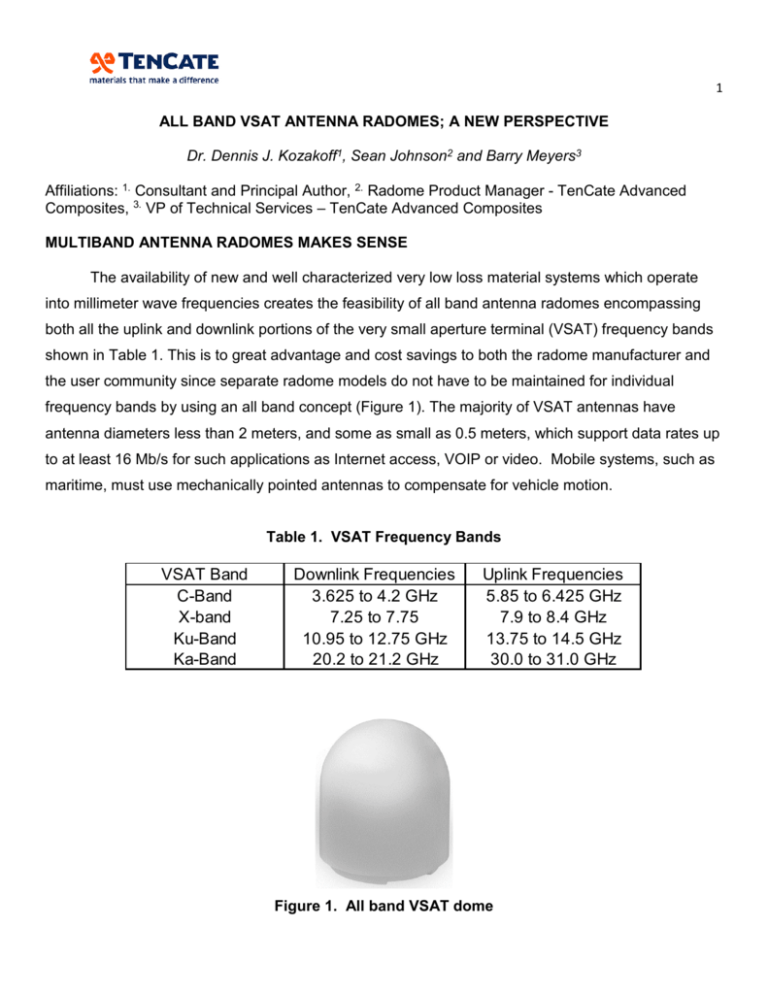
1 ALL BAND VSAT ANTENNA RADOMES; A NEW PERSPECTIVE Dr. Dennis J. Kozakoff1, Sean Johnson2 and Barry Meyers3 Affiliations: 1. Consultant and Principal Author, 2. Radome Product Manager - TenCate Advanced Composites, 3. VP of Technical Services – TenCate Advanced Composites MULTIBAND ANTENNA RADOMES MAKES SENSE The availability of new and well characterized very low loss material systems which operate into millimeter wave frequencies creates the feasibility of all band antenna radomes encompassing both all the uplink and downlink portions of the very small aperture terminal (VSAT) frequency bands shown in Table 1. This is to great advantage and cost savings to both the radome manufacturer and the user community since separate radome models do not have to be maintained for individual frequency bands by using an all band concept (Figure 1). The majority of VSAT antennas have antenna diameters less than 2 meters, and some as small as 0.5 meters, which support data rates up to at least 16 Mb/s for such applications as Internet access, VOIP or video. Mobile systems, such as maritime, must use mechanically pointed antennas to compensate for vehicle motion. Table 1. VSAT Frequency Bands VSAT Band C-Band X-band Ku-Band Ka-Band Downlink Frequencies 3.625 to 4.2 GHz 7.25 to 7.75 10.95 to 12.75 GHz 20.2 to 21.2 GHz Uplink Frequencies 5.85 to 6.425 GHz 7.9 to 8.4 GHz 13.75 to 14.5 GHz 30.0 to 31.0 GHz Figure 1. All band VSAT dome 2 SPECIAL PROBLEMS WITH VSAT ANTENNA RADOMES VSAT broadband networks deliver the high data speeds to reliably support a range of critical applications [1]. As the user community migrates toward higher bandwidth, the newer Ka-band satellite services have gained much customer popularity as “the wave of the future” for SATCOM because the spectrum is relatively unused while the lower frequency satellite bands are all heavily subscribed. But the use of small SATCOM antennas associated with VSAT and the move toward Ka band frequencies introduce a number of considerations. For instance, satellite applications having multiple widely separated downlink and uplink frequencies demand either exceptionally broadband low loss antenna radome systems or design approaches which focus on achieving the low transmission losses only within the downlink and uplink frequency bands; the latter has been shown as a more viable approach [2]. A priority needs to be placed on the downlink frequency bands since radome loss translates directly into increase in antenna noise temperature, decrease in the antenna gain to noise temperature ratio (G/T) and increase in digital bit error rates (BER). Downlink radome loss cannot be compensated for and the loss increases the system noise floor. Radome loss at the transmit frequency bands can be compensated for by an increase in transmit power. Consider that for a SATCOM receiver connected to a VSAT antenna, the received energy per bit to noise density ratio ( Eb / N o ) is directly proportional to the antenna G/T. If G/T decreases by one dB, then Eb / N o decreases by one dB. The quadrature phase shift keying (QPSK) BER is approximated by the formula [3]: e− x BER = 2x π 2 where x= Eb No Herein is the problem with small VSAT antennas: the G/T ratio diminishes faster than the gain G does due to radome loss: the problem gets worse as the antenna dish size becomes smaller. For instance, if G decreased 1 dB the G/T might decrease by 2 dB. What all this amounts to is that for small VSAT antennas, maintaining very low radome loss must be a major priority. High losses will 3 not only degrade antenna noise temperature but increase digital bit error rate and reduce data speed since error correction codes have to be employed. ESTIMATING PERFORMANCE OF AN ALL BAND VSAT RADOME CANDIDATE To estimate the low loss potential of an all band VSAT radome, an A-sandwich radome having the candidate skin materials shown in Table 2 was considered. Of specific interest was the goal of minimizing both the increase in antenna noise temperature and the increase in system BER due to the radome losses. Something to be considered is that some installations may require greater wall strength for environmental reasons; because of this both one ply outer layer and two plies outer layer conditions were both analyzed (prepreg plies are multiples of 0.011 inch). Table 2. Candidate Radome Materials Resin Reinforcement Dielectric Constant Loss Tangent BTCy-2 Cyanate Ester 4581 Quartz 7781 E-glass 3.15 4.11 0.001 0.002 For an all quartz radome and an antenna diameter of 0.5 meters, a summary of radome losses at the downlink and uplink frequencies are shown in Table 3. For the downlink bands the loss was extremely low thereby assuring minimal increase in antenna noise temperature and BER degradation. Uplink losses were also very small except for Ka band; this could be compensated for the additional transmit power. Table 3. Summary for TenCate BTCy-2 cyanate ester based radomes4 Condition one ply outer quartz and one ply inner quartz skins two ply outer quartz and one ply inner quartz skins DOWN LINK Freq (GHz) Loss (dB) 3.90 -0.017 7.70 -0.062 11.85 -0.028 20.70 -0.082 3.90 -0.022 7.70 -0.126 11.85 -0.050 20.70 -0.290 UP LINK Freq (GHz) Loss (dB) 6.15 -0.017 8.15 -0.075 14.10 -0.107 30.60 -0.719 6.15 -0.038 8.15 -0.146 14.10 -0.270 30.60 -1.471 4 Other results, not shown, investigated the potential of using a one ply inner cyanate ester fiberglass prepreg skin in an attempt to reduce costs in high volume production; that is the ester cyanate quartz prepreg was only used for the outer radome skin layers. The loss penalty was in the order of -0.5 dB increase at the Ka-band uplink frequency while the downlink frequencies experienced additional losses less than -0.2 dB. CONCLUSIONS The feasibility of an all band VSAT radome was demonstrated utilizing low loss cyanate ester quartz prepreg materials. The analysis not only considered radome loss, but other factors such as radiometric heating (increase in antenna noise temperature) and the increase in digital bit error rate. Over most of the receive frequency bands radiometric heating was negligible for the selected materials (less than 10 degrees Kelvin) thereby minimizing the impact on other VSATcommunications receiver parameters. The transmission losses at the downlink frequencies were all extremely small. REFERENCES [1] Gilat Satellite Networks, Boundless Communications, Satellite Evolution Magazine, May/June 2011. [2] Kozakoff, D.J., Millimeter Wave Antenna Radome Systems for Satellite on the Move Applications, Antenna Systems and Technology Magazine, Fall 2013 [3] Kozakoff, D. J. and R. Ciano, Antenna Radome Effects on High Performance SOTM Antenna Systems, Antenna Systems 2013, Las Vegas, NV, December 2013 [4] TenCate Advanced Composites BTCy-2 cyanate ester technical data sheet TenCate Advanced Composites is a leading supplier of low dielectric/low loss quartz based composite prepregs serving the military, marine and commercial aircraft industry. Visit www.tencateadvancedcomposites.com or email us at info@tcac-usa.com for more information. Dr. Kozakoff, Principal Author, with over thirty years in industry, is author of “Analysis of Radome Enclosed Antennas”, Artech House, 2010, a chapter coauthor of the “Antenna Engineering Handbook”, McGraw Hill, 2007, and numerous other publications. .
